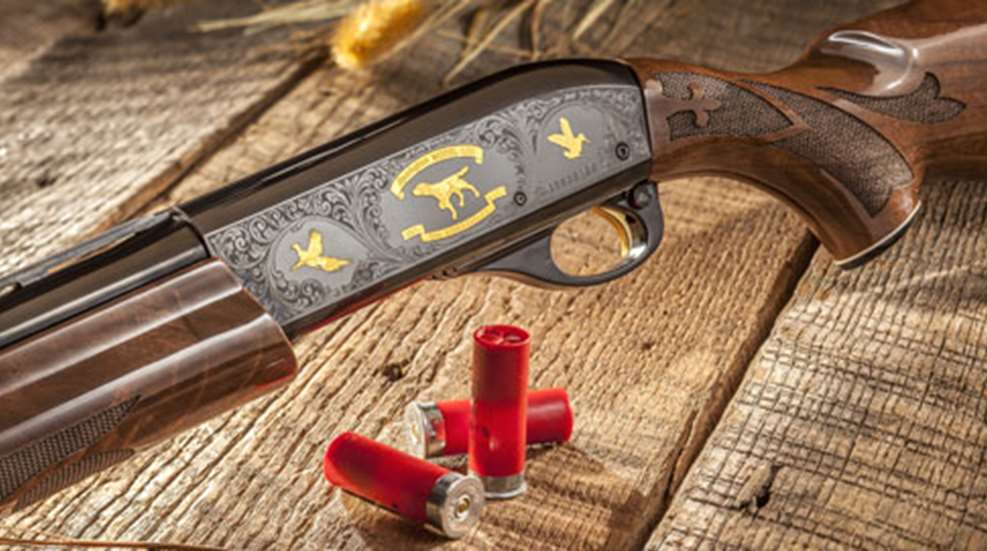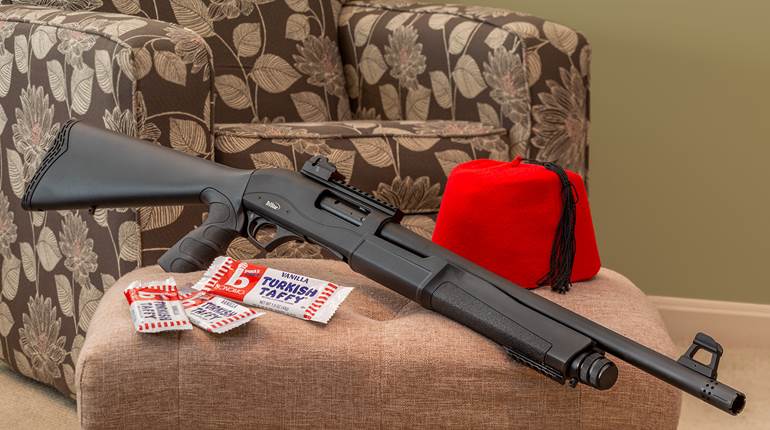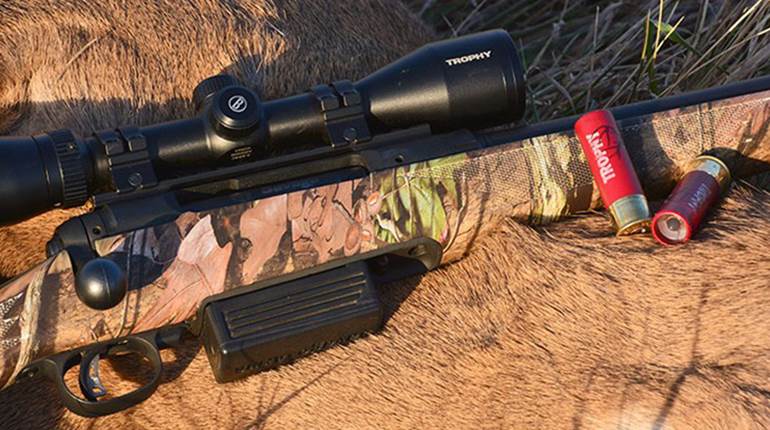
Remington introduced its first semi-automatic shotgun in 1906. Called the Remington Autoloading Shotgun and then the Model 11, it was basically an American version of the Belgian-made Browning Auto-5 with a few differences, such as no magazine cut-off and a slightly different barrel design. Both were designed by John Browning. Just more than 850,000 Model 11s were built before it was replaced by the Model 11-48 in 1948. The streamlined receiver of the new shotgun was a sign of more modern things to come at Remington, but it still utilized Browning’s long-recoil design in which both the bolt and barrel traveled to the rear during firing.
It was no secret that a gas-operated shotgun had been under development at several American firearm companies, and it was commonly assumed that either Remington or Winchester would be first to introduce one. Instead, in 1956 Sears, Roebuck & Co. beat everyone to the punch with its new J.C. Higgins Model 60 in 12 gauge. Capable of handling all 2 ¾-inch loads, it was designed and built for Sears by the High Standard Mfg. Corp.
During the 1930s Remington had produced its Model 500 series of bolt-action and semi-automatic rifles in .22, of interest because of their interchangeable parts. That “firearm family” proved to be successful, and during the late 1940s management decided to expand on the concept by developing a series of shotguns and center-fire rifles with similar receivers and some parts commonality.
First to be introduced in 1950 was the Model 870 pump shotgun. It was followed two years later by the Model 760 center-fire rifle on the same type of action. The Model 740, a gas-operated rifle in .30-’06 Sprg., came along in 1955. The next member to join the family was Remington’s first gas-powered shotgun, the Sportsman 58. It was introduced in 1956, shortly after J.C. Higgins guns began to appear on the shelves of Sears stores across the country. Unlike the Model 60, which handled both light and heavy 2¾-inch loads, the Sportsman 58 was equipped with a “Dial-A-Matic” magazine cap with gas vents of different sizes. When a light target load was to be used, the cap was twisted to “L”; twisting it to “H” readied the gun for heavy field loads.
In 1959, Remington introduced its second gas-operated shotgun called the Model 878 Automaster. It was much like the Sportsman 58 except its self-compensating gas piston allowed the use of both light and heavy loads without making any mechanical adjustment.
The Sportsman 58 and Model 878 were designed by a team headed by L.R. Crittendon and, while many hunters and clay target shooters loved the two guns, Remington management acknowledged the fact that both fell short of perfection. For close to three years a young engineer by the name of Wayne Leek and his team consisting of Clark Workman, James Martin, R.P. Kelly and Charles Morse devoted a big part of their time to making improvements to the Model 878. They eventually came up with a shotgun that would go on to become second only in popularity to the Model 870 pump. When introducing it to members of Remington’s advertising agency in December 1962, Leek proudly stated “Gentlemen, this is the new Model 1100, and it’s going to revolutionize shotgun shooting.” And indeed it did.
Every person involved in the design of the Model 1100 was either a hunter or an avid clay target shooter, and some were both. One of their goals was to produce a shotgun that was easy to keep clean when subjected to high-volume shooting. The gas pistons of other shotguns were located inside the magazine tubes. Locating it on the outside of the tube of the Model 1100 made everything easily accessible for cleaning. And yet the compactness of the piston and its associated parts resulted in a trimmer fore-end than on other gas-operated guns. Moving the gas port of the barrel closer to the chamber where pressure was higher resulted in less buildup of propellant fouling in the system.
In those days a computer filled a good-sized room, and one of those along with an oscilloscope revealed that the new gas-handling design prolonged the recoil curve, thereby reducing perceived recoil compared not only to recoil-operated shotguns but to other gas guns as well. Guns that were function-tested after being frozen at 32 degrees below zero overnight never missed a lick. Oil-coated guns were dropped into sand pits, others were submerged in water. All came out shooting. The barrels of test guns subjected to sustained-firing became so hot their fore-ends began to smoke. More than half-a-million shells were fired.
To make sure the balance and feel of the new gun would satisfy as many shooters as possible, dozens of Remington employees were asked to shoot guns with varying stock dimensions. Their opinions and suggestions had a lot of influence on final stock design and shape. Pointing and swinging qualities of the gun were further improved by positioning its balance point a bit closer to the shooter’s forward hand than the rear. That was accomplished in part by making the receiver as trim as possible. Years ago, the late Don Zutz wrote that the Model 1100 receiver is actually shallower than some over-under shotguns. He was right. I have a Remington Model 3200 in 12 gauge, and its receiver at the standing breech is 0.280 inches deeper than the 12-gauge Model 1100. In fact, the Model 1100 receiver is both shallower and thinner than the receiver of my 1960s-vintage Winchester 101 in 20 gauge.
The stock and fore-end of early guns had impressed checkering and were given an extremely durable polyurethane finish originally developed by DuPont for use on bowling pins. To illustrate its toughness, Remington produced a promotional film starring employees Earl Larson, Jack Heath and Dick Baldwin in which stocks set up in a bowling alley were repeatedly knocked asunder. It also had a special rack installed on the roof of the factory in order to expose dozens of stocks to the elements for several weeks.
The Model 1100 was announced in January 1963 in 12 gauge only at $149.95 for a plain barrel and $174.95 for a barrel with ventilated rib. At the time, the plain-barrel Browning Auto-5 was selling for $154.95 and Winchester’s lightweight Model 59 with its fiberglass-reinforced barrel was going for $149.95. Model 1100s in Field, Skeet and Trap configurations were chambered for the 2 ¾-inch shell but a Magnum Duck Gun with 3-inch chamber was also offered. During the next year, 16 and 20 gauges were added to the Field and the Skeet guns. The 12-gauge Deer Gun with adjustable sights and 22-inch smoothbore barrel made its debut in 1966. Three years later a 20-gauge Deer Gun was introduced.
In 1969 the first 1100s in 28 gauge and .410 bore were built, both on a smaller receiver. Field guns had stocks of mahogany, while Skeet guns wore walnut. The smallbore Skeet guns were later offered individually but, during the first year of production, they were available only as a sequentially serial numbered pair in a hard case. Production of the Matched Pairs ceased in 1970 with 5,067 built, although the remaining stock lasted until 1972.
Through 1969, all 20-gauge Model 1100s were built on the 12-gauge receiver. A Lightweight version with a mahogany stock was offered, but it still weighed only a few ounces less than a 12-gauge gun. Skeet shooters absolutely loved the weight for its reduction in recoil, and even today those guns bring a premium on the used gun market, if one can be found.
Trap shooters probably welcomed the new Model 1100 even more. Whereas skeet shooters use light loads and prefer to shoot the lighter-kicking 20, 28 and .410 shells, trap shooters shoot only heavy 12-gauge loads. Even today Model 1100s continue to be used by several of the trap shooters at my gun club.
The standard 12-gauge Model 1100 weighed 7 pounds, 8 ounces, while the magnum version weighed a quarter-pound more. Target shooters and hunters were quite happy with those weights but most hunters considered the 20-gauge gun on the 12-gauge receiver heavier than necessary. And since hunters were buying far more shotguns than were clay target shooters, the Lightweight 20 on the 28/.410 receiver was introduced in 1970. To my knowledge, the Model 1100 and the Model 11-48 are the only two semi-automatic shotguns ever produced in 12, 16, 20, 28 and .410.
Jay Bunting of Remington, who shot skeet with 1100s for many years, recently pointed out to me that the Lightweight 20 was made in two versions. The LW-20 offered from 1970 to 1976 had a short barrel extension much like the Model 870, while the LT-20, which replaced it in 1977, had a standard-length extension with integral ejection stud and an enlarged ejection port. Both versions were originally chambered only for the 2 ¾-inch shell, but in 1971 the LT became available with a 3-inch chamber.
The one-millionth Model 1100 came off the production line in 1972. During that same year, left-hand 12- and 20-gauge Field and Skeet guns with the ejection port on the left side of the receiver and the safety reversed for the southpaw shooter were introduced. Model 1100 production reached the 2,000,000 mark in March 1977. The left-hand gun in 20 gauge was discontinued in 1978 and the 20-gauge Deer Gun on the 12-gauge receiver was replaced by one on the 28/.410 receiver. Also during that year, the mahogany stock of the LT-20 Field was replaced with walnut.
The standard Field gun was designed to function only with the 2 ¾-inch shell while the Magnum was intended exclusively for the 3-inch shell. In those days it was quite common for a shooter to own one Model 1100 and several barrels with different choke constrictions. To add a bit more sales appeal to the Magnum gun, Remington modified it in 1979 so it could be used with an extra barrel chambered for the 2 ¾-inch shell.
Model 1100 production reached 3,000,000 in 1983. That was also the year a left-hand version of the Deer Gun in 12 gauge was introduced, as was the Special Field in 12 and 20 gauges with straight-grip stock and stubby 21-inch, ventilated-rib barrel. The year 1985 saw the introduction of the Special Purpose Magnum, an economy-grade waterfowl and turkey gun with a birch stock and dull blued finish.
Selling extra barrels for its shotguns had long been quite profitable for Remington and the company resisted offering screw-in chokes long after they became available on guns from other manufacturers. The Rem Choke system was introduced in 1986.
The Model 11-87-capable of handling both the 2 ¾- and 3-inch interchangeably and introduced in 1987-did not replace the Model 1100, but the passing of each year brought a reduction in the number of Model 1100 variations offered. Interchangeability matters not to clay target shooters, but when steel shot became a requirement on waterfowl, guns that could not take both 2¾- and 3-inch shells lost market share. By 1988 only the Special Field was offered in 12 gauge although Field guns in 20, 28 and .410 as well as Skeet guns in those chamberings were still cataloged. When the 1991 catalog was published only the “Small Gauge” Field gun in 20, 28 and .410 and the 20-gauge Youth Gun with short length of pull and a 21-inch barrel made the cut. By 1995 most field-grade Model 1100s had been discontinued although others would continue to be occasionally offered on a limited basis.
As I write this, Remington is offering six standard-production variants. Twelve-gauge guns include: the Competition, with fancy walnut stock and 30-inch backbored barrel with lengthened forcing cone; the Competition Synthetic, with a stock quick-adjustable for cast, length of pull and comb height; the Classic Trap, with high-comb walnut stock and 30-inch Rem Choke barrel; and the Tactical, with black synthetic stock, 22-inch ventilated-rib barrel and eight-round magazine. The Sporting is offered in 12 and 20 gauges while the Premier Sporting, with its fancy walnut and nickel-plated receiver and gold inlay, is available in 12, 20 and 28 gauges and .410 bore. Available during 2013 is the 12-gauge, 50th Anniversary Limited Edition with B-Grade walnut, 1963 prefix serial number and machine-engraved receiver.
The Model 1100 is more prone to parts breakage than some designs, but that mattered less to hunters than to those who shot many thousands of rounds each year on the trap and skeet fields. Even when a part broke, its replacement was cheap and usually easy to install. Most clay target shooters kept on hand spare parts such as the action spring, barrel seal, link and piston seal. Several of the guys at my gun club competed during the glory days of the Model 1100, and one recently told me that he usually replaced the action spring about every 12,000 rounds, whether it needed it or not.
The Model 1100 was an even bigger hit among hunters. For as long as I can remember, my father hunted quail several days each week of the season and while he was a double man at heart, the gun he used most during his last 25 years in the field was a LT-20 skeet gun. He gave it a good cleaning every couple of months and the only part that ever broke was a barrel seal, an inexpensive rubber O-ring that slips over the magazine tube.
The autoloading shotgun market is much broader today, with some guns better in ways than the Model 1100-including the improved Remington Model 11-87-but few manufacturers have managed to duplicate its handling qualities. The fact that upward of 4,000,000 have been sold since its introduction half a century ago is proof that Wayne Leek and his team got it right.







































